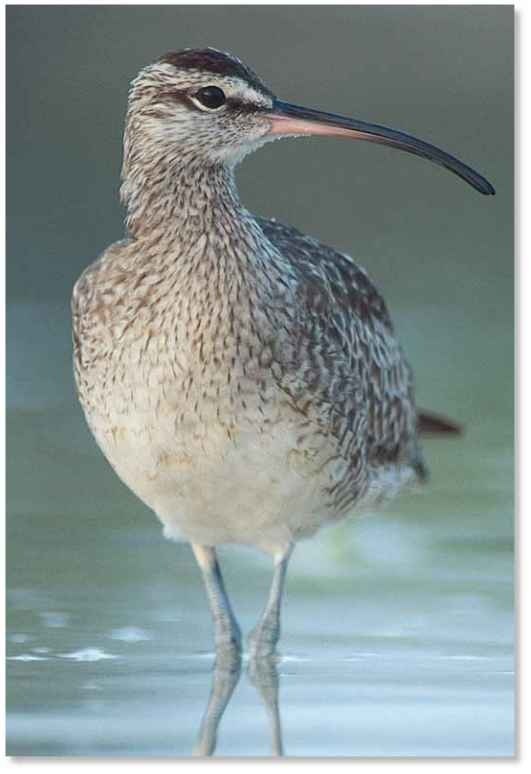ORDER
Charadriiformes
FAMILY
Scolopacidae
GENUS & SPECIES
key features
• Relies more on its keen eyesight than its I sensitive bill when I searching for food
• Prefers mudflats, rocky shores and beach habitats, where it will forage for food in one area much longer than other wading birds
• Chicks search for their own food from birth, but must still be brooded for warmth by the parents
where in the world?
Found in northern Europe, Asia and North America; winters from southwest Europe and Africa, through the Middle East to west India and also in Australia, Central and South America
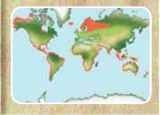
LIFECYCLE
Usually traveling in small flocks, whimbrels are gregarious birds that keep up their search for food even when other wading birds have moved on.
HABITAT
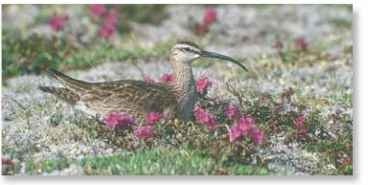
A Distinct profile The whimbrel’s bill is the perfect feeding tool in all types of habitats.
The whimbrel lives on tidal flats, coastal wetlands and grasslands. In winter, the whimbrel occupies exposed reefs, muddy, rocky or sandy beaches, tidal mudflats and mangrove swamps. Whimbrel communities will roost in mangrove swamps on the ground or perch high in mangrove trees.This medium-sized bird is also comfortable in subarctic and sub-alpine moorland, birch forest and tundra, open forest and river valleys. During migration, the whimbrel roosts in shallow water at night; by day it will feed off inland grassland. In the spring, it prefers heathland and farmland.
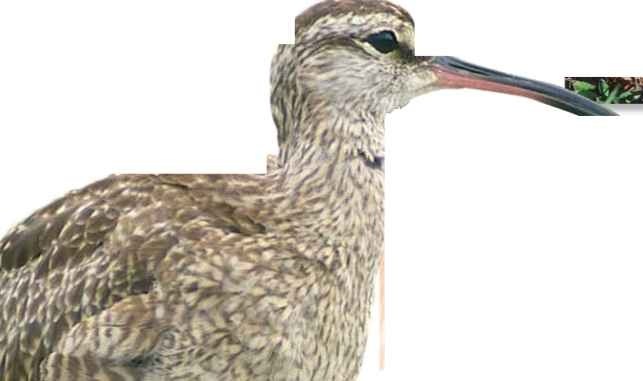
BREEDING
Male whimbrels arrive first at breeding grounds and establish territories. Following the males’ aerial courtship displays and elaborate vocalizations, the female makes her choice.The nest is a simple depression, filled with fragments of vegetation, in an exposed location. Both male and female whimbrels incubate the clutch, which usually consists of no more than four eggs. Chicks are colored warm buff with brown and are able to walk and pick up food items within a few hours of hatching.The chicks are responsible for finding all of their own food, but the parents will brood the young for about 35-40 days after they hatch in order to keep them warm, since the young are unable to keep their body temperature constant for very long. The broods of different parents and even different species may come together to form large groups, called creches; often one or both parents leave the young in the care of another bird. These creches of waders serve as defense against predators, since a group can more easily detect and mob predators. However; mortality rates both with or without a creche may reach 30% for a number of reasons, including lack of food and warmth, and attacks by predators, such as Arctic foxes, buzzards, owls and gulls.
FIRST ONE OUT
While the other chicks keep pecking, one breaks free.
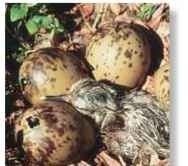
Whimbrels periodically molt the lining of their ) gizzard. These linings, which look like small yellowish bags, have been found in great numbers on the roosting sites of northward-migrating whimbrels and are believed to prevent the buildup of stomach parasites.
Whimbrel eggs are pear-shaped (pyriform) so that the pointed ends of the 3-4 eggs fit together in the center of the nest scrape. Even if the eggs roll, they roll in circles and never far away from the incubating bird. This is true of all birds in the family Scolopacidae.
CONSERVATION
Because of its extremely extensive breeding range, the whimbrel is probably the most abundant curlew.With eastern Atlantic flyway populations alone estimated at 600,000-700,000 birds, the whimbrel is not globally threatened. During the late 1970s there was a natural decline in populations, but they are now increasing.
BEHAVIOR
The whimbrel is a persistent forager, often seen probing when other birds have retired for the evening. When the whimbrel flies to a new area, it rises to great heights and then descends in circles as it nears the ground.
While migrating, whimbrels will often roost communally with other wading birds. High-tide tree roosts offer a perfect view of prey and predators. The mass roost offers safety from predators; the whimbrel issues harsh alarm calls if a threat is approaching. Other vocalizations begin when whimbrels organize for migration. Flight groups of up to 100 birds will stay in the V-formation during long journeys, which can cover more than 1,000 miles.
Mass watch Whimbrels rely on their keen eyesight to spot the movements of prey and predators.
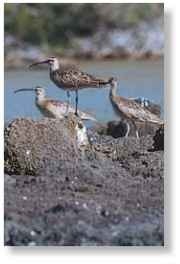
FOOD & FEEDING
The whimbrel’s downward-curving bill is highly specialized, serving as a probing and pecking tool as the bird searches for food. The wading whimbrel will use its long, thin bill to poke into burrows for crabs, a favored delicacy. Once it captures prey in the bill, the bird manipulates it with its tongue to bring it further back into its mouth. The whimbrel’s long bill removes long and soft-bodied prey, such as worms and mollusks, intact and tears larger victims, which include reptiles and birds, into bite-sized pieces.
The whimbrel generally forages in small groups or individually, along the coast or inland during migration. Inland birds eat insects (such as beetles and cranefly larvae), spiders, snails and slugs. During the breeding season in the spring, the whimbrel will also eat the berries, seeds and leaves that become plentiful.
VERSATILE FEEDERS
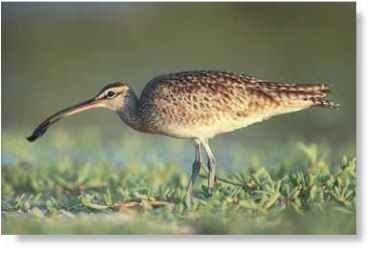
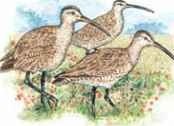
Berry nice…
A small group of whimbrels walks purposefully across the vast tundra plain in search of bushes bearing berries.
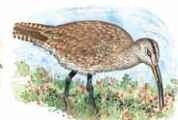
Peck away…
The bird uses its long bill to peck at a variety of berries, including cranberries, cowberries and
crowberries.

Time for seafood…
Whimbrels probe along coastal areas in the sand, using their long downward-curving bills to dig into small crevices.
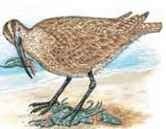
Delicacy within reach
Extracting a small crab from its burrow, this bird uses its strong bill to rip its prey into bite-sized
pieces.
PROFILE
Whimbrel
The whimbrel stands out among curlews with a prominent dark stripe on its sides and crown; strong wings enable it to make long migratory flights.
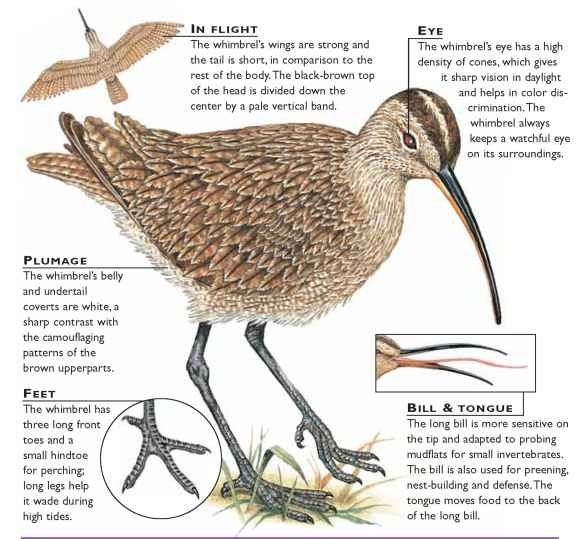
CREATURE COMPARISONS
The Far Eastern curlew (Numenius madagascariensis) is larger than the whimbrel and is the largest of all curlews at 26″. Both birds have similar coloration, though the Far Eastern curlew lacks the whimbrels bold head markings, and has buff rather than white underparts.The Far Eastern curlew is found in Mongolia, Siberia, Central China, the Philippines, New Guinea and New Zealand. A long-distance migrant like its cousin, the curlew nests in small colonies of 2-3 pairs between May and June.The curlew matures later than the whimbrel; juveniles do not reach sexual maturity until 3-4 years of age.
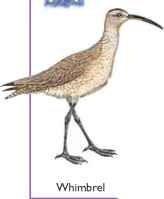

Far Eastern curlew
| vital statistics Weight About 1 lb. |
|
| Length | 14-18″ |
| Wingspan | 32″ |
| Sexual Maturity | 1-2 years |
| Breeding Season | May-June |
| Number of Eggs | 4 |
| Incubation PERIOD |
27-28 days |
| Fledging Period | 35-42 days |
| Birth Interval | 1 year |
| Typical Diet | Aquatic invertebrates, sandhoppers, insects, crabs, mollusks and fruit |
| Lifespan | Over 11 years |
Related species
• The whimbrel is one of 8 species in the genus J Numenius; close relatives [ include the long-billed | curlew, N. americanus, and the bristle-thighed curlew, N. tahitiensis. There are 24 genera and 86 species in the Scolopacidae family, which includes wading birds such as snipes, dowitchers, sandpipers, phalaropes, turnstones, woodcocks, curlews, godwits and shanks.
